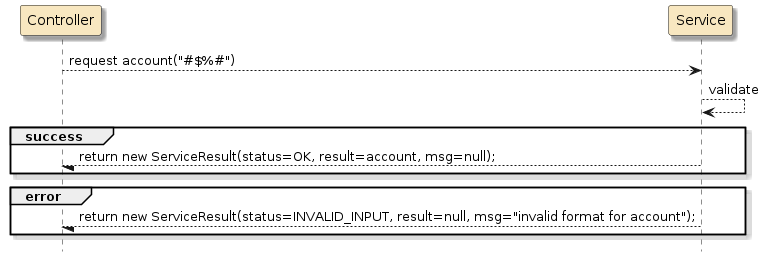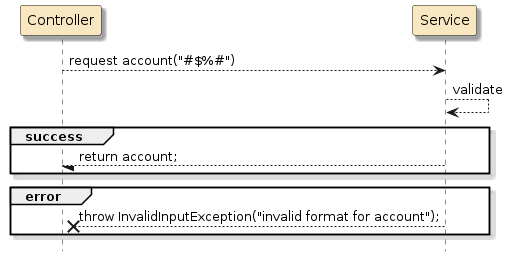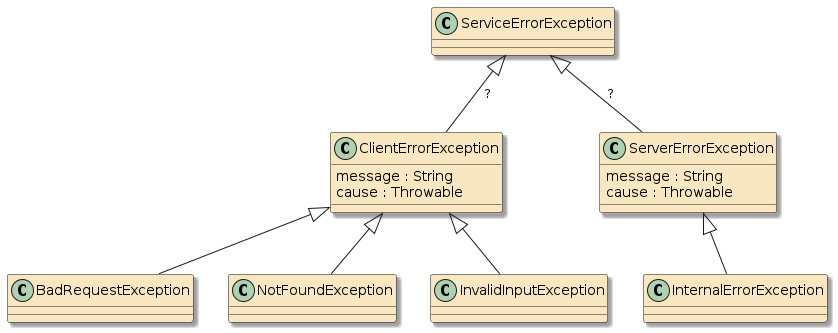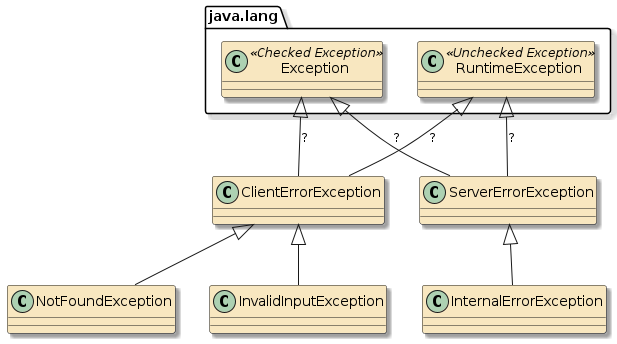1. Introduction
Many times we may think of a service from the client’s perspective and term everything on the other side of the HTTP connection to be "the service". That is OK from the client’s perspective, but even a moderately-sized service — there are normally a few layers of classes playing a certain architectural role and that front-line controller we have been working with should primarily be a "web facade" interfacing the business logic to the outside world.

In this lecture we are going to look more closely at how the overall endpoint breaks down into a set of "facade" and "business logic" pattern players and lay the groundwork for the "Data Transfer Object" (DTO) covered in the next lecture.
1.1. Goals
The student will learn to:
-
identify the Controller class as having the role of a facade
-
encapsulate business logic within a separate service class
-
establish some interface patterns between the two layers so that the web facade is as clean as possible
1.2. Objectives
At the conclusion of this lecture and related exercises, the student will be able to:
-
implement a service class to encapsulate business logic
-
turn
@RestControllerclass into a facade and delegate business logic details to an injected service class -
identify error reporting strategy options
-
identify exception design options
-
implement a set of condition-specific exceptions
-
implement a Spring
@RestControllerAdviceclass to offload exception handling and error reporting from the@RestController
2. Roles
In an N-tier, distributed architecture there is commonly a set of patterns to apply to our class design.

-
Business Logic - primary entry point for doing work. The business logic knows the why and when to do things. Within the overall service — this is the class (or set of classes) that make up the core service.
-
Data Transfer Object (DTO) - used to describe requested work to the business logic or results from the business logic. In small systems, the DTO may be the same as the business objects (BO) stored in the database — but the specific role that will be addressed here is communicating outside of the overall service.
-
Facade - this provides an adapter around the business logic that translates commands from various protocols and libraries — into core language commands.
I will cover DTOs in more detail in the next lecture — but relative to the client, facade, and business logic — know that all three work on the same type of data. The DTO data types pass thru the controller without a need for translation — other than what is required for communications.
Our focus in this lecture is still the controller and will now look at some controller/service interface strategies that will help develop a clean web facade in our controller classes.
3. Error Reporting
When an error occurs — whether it be client or internal server errors — we want to have access to useful information that can be used to correct or avoid the error in the future. For example, if a client asks for information on a particular account that cannot be found, it would save minutes to hours of debugging to know whether the client requested a valid account# or the bank’s account repository was not currently available.
We have one of two techniques to report error details: complex object result and thrown exception.
|
Design a way to allow low-level code report context of failures
The place were the error is detected is normally the place with the
most amount of context details known. Design a way to have the information
from the detection spot propagated to the error handling.
|
3.1. Complex Object Result
For the complex object result approach, each service method returns a complex result object (similar in concept to ResponseEntity). If the business method is:
-
successful: the requested result is returned
-
unsuccessful: the returned result expresses the error
The returned method type is complex enough to carry both types of payloads.

|
Complex return objects require handling logic in caller
The complex result object requires the caller to have error handling logic
ready to triage and react to the various responses. Anything that is not immediately
handled may accidentally be forgotten.
|
3.2. Thrown Exception
For the thrown exception case, exceptions are declared to carry failure-specific error reporting. The business method only needs to declare the happy path response in the return of the method and optionally declare try/catch blocks for errors it can address.

|
Thrown exceptions give the caller the option to handle or delegate
The thrown exception technique gives the caller the option to construct a
try/catch block and immediately handle the error or to automatically let it
propagate to a caller that can address the issue.
|
Either technique will functionally work. However, returning the complex object versus exception will require manual triage logic on the receiving end. As long as we can create error-specific exceptions, we can create some cleaner handling options in the controller.
3.3. Exceptions
Going the exception route, we can start to consider:
-
what specific errors should our services report?
-
what information is reported?
-
timestamp
-
(descriptive? redacted?) error text
-
-
are there generalizations or specializations?
The HTTP organization of status codes is a good place to start thinking of error types and how to group them (i.e., it is used by the world’s largest information system — the WWW). HTTP defines two primary types of errors:
-
client-based
-
server-based
It could be convenient to group them into a single hierarchy — depending on how we defined the details of the exceptions.

From the start, we can easily guess that our service method(s) might fail because
-
NotFoundException: the target entity was not found
-
InvalidInputException: something wrong with the content of what was requested
-
BadRequestException: request was not understood or erroneously requested
-
InternalErrorException: infrastructure or something else internal went bad
We can also assume that we would need, at a minimum
-
a message - this would ideally include IDs that are specific to the context
-
cause exception - commonly something wrapped by a server error
3.4. Checked or Unchecked?
Going the exception route — the most significant impact to our codebase will be the choice of checked versus unchecked exceptions (i.e., RuntimeException).
-
Checked Exception - these exceptions inherit from java.lang.Exception and are required to be handled by a try/catch block or declared as rethrown by the calling method. It always starts off looking like a good practice, but can get quite tedious when building layers of methods.
-
RuntimeException - these exceptions inherit from java.lang.RuntimeException and not required to be handled by the calling method. This can be a convenient way to address exceptions "not dealt with here". However, it is always the caller’s option to catch any exception they can specifically address.

If we choose to make them different (i.e., ServerErrorException unchecked and ClientErrorException checked), we will have to create separate inheritance hierarchies (i.e., no common ServiceErrorException parent).
3.5. Candidate Client Exceptions
The following is a candidate implementation for client exceptions. I am going to go the seemingly easy route and make them unchecked/RuntimeExceptions — but keep them in a separate hierarchy from the server exceptions to allow an easy change. Complete examples can be located in the repository
public abstract class ClientErrorException extends RuntimeException {
protected ClientErrorException(Throwable cause) {
super(cause);
}
protected ClientErrorException(String message, Object...args) {
super(String.format(message, args)); (1)
}
protected ClientErrorException(Throwable cause, String message, Object...args) {
super(String.format(message, args), cause);
}
public static class NotFoundException extends ClientErrorException {
public NotFoundException(String message, Object...args)
{ super(message, args); }
public NotFoundException(Throwable cause, String message, Object...args)
{ super(cause, message, args); }
}
public static class InvalidInputException extends ClientErrorException {
public InvalidInputException(String message, Object...args)
{ super(message, args); }
public InvalidInputException(Throwable cause, String message, Object...args)
{ super(cause, message, args); }
}
}| 1 | encourage callers to add instance details to exception by supplying built-in, optional formatter |
The following is an example of how the caller can instantiate and throw the exception based on conditions detected in the request.
if (null==gesture) {
throw new ClientErrorException
.NotFoundException("gesture type[%s] not found", gestureType);
}3.6. Service Errors
The following is a candidate implementation for server exceptions. These types of errors are commonly unchecked.
public abstract class ServerErrorException extends RuntimeException {
protected ServerErrorException(Throwable cause) {
super(cause);
}
protected ServerErrorException(String message, Object...args) {
super(String.format(message, args));
}
protected ServerErrorException(Throwable cause, String message, Object...args) {
super(String.format(message, args), cause);
}
public static class InternalErrorException extends ServerErrorException {
public InternalErrorException(String message, Object...args)
{ super(message, args); }
public InternalErrorException(Throwable cause, String message, Object...args)
{ super(cause, message, args); }
}
}The following is an example of instantiating and throwing a server exception based on a caught exception.
try {
//...
} catch (RuntimeException ex) {
throw new InternalErrorException(ex, (1)
"unexpected error getting gesture[%s]", gestureType); (2)
}| 1 | reporting source exception forward |
| 2 | encourage callers to add instance details to exception by supplying built-in, optional formatter |
4. Controller Exception Advice
We saw earlier where we could register an exception handler within the controller class and how that could clean up our controller methods of noisy error handling code. I want to now build on that concept and our new concrete service exceptions to define an external controller advice that will handle all registered exceptions.
The following is an example of a controller method that is void of error handling logic because of the external controller advice we will put in place.
@RestController
public class GesturesController {
...
@RequestMapping(path=GESTURE_PATH,
method=RequestMethod.GET,
produces = {MediaType.TEXT_PLAIN_VALUE})
public ResponseEntity<String> getGesture(
@PathVariable(name="gestureType") String gestureType,
@RequestParam(name="target", required=false) String target) {
//business method
String result = gestures.getGesture(gestureType, target); (1)
String location = ServletUriComponentsBuilder.fromCurrentRequest()
.build().toUriString();
return ResponseEntity
.status(HttpStatus.OK)
.header(HttpHeaders.CONTENT_LOCATION, location)
.body(result);
}| 1 | handles only successful result — exceptions left to controller advice |
4.1. Service Method with Exception Logic
The following is a more complete example of the business method within the service class. Based on the result of the interaction with the data access tier — the business method determines the gesture does not exist and reports that error using an exception.
@Service
public class GesturesServiceImpl implements GesturesService {
@Override
public String getGesture(String gestureType, String target) {
String gesture = gestures.get(gestureType); //data access method
if (null==gesture) {
throw new ClientErrorException (1)
.NotFoundException("gesture type[%s] not found", gestureType);
} else {
String response = gesture + (target==null ? "" : ", " + target);
return response;
}
}
...| 1 | service reporting details of error |
4.2. Controller Advice Class
The following is a controller advice class.
We annotate this with @RestControllerAdvice to better describe its role and give us the option to create fully annotated handler methods.
My candidate controller advice class contains an internal helper method that programmatically builds a ResponseEntity.
The type-specific exception handler must translate the specific exception into a HTTP status code and body.
A more complete example — designed to be a base class to concrete @RestControllerAdvice classes — can be found in the repository.
package info.ejava.examples.svc.httpapi.gestures.controllers;
import org.springframework.http.HttpStatus;
import org.springframework.http.ResponseEntity;
import org.springframework.web.bind.annotation.RestControllerAdvice;
@RestControllerAdvice( (1)
// wraps ==> @ControllerAdvice
// wraps ==> @Component
basePackageClasses = GesturesController.class) (2)
public class ExceptionAdvice { /(3)
//internal helper method
protected ResponseEntity<String> buildResponse(HttpStatus status, (4)
String text) { (5)
return ResponseEntity
.status(status)
.body(text);
}
...| 1 | @RestControllerAdvice denotes this class as a @Component that will handle thrown exceptions |
| 2 | optional annotations can be used to limit the scope of this advice to certain packages and controller classes |
| 3 | handled thrown exceptions will return the DTO type for this application — in this case just text/plain |
| 4 | type-specific exception handlers must map exception to an HTTP status code |
| 5 | type-specific exception handlers must produce error text |
|
Example assumes DTO type is
This example assumes the DTO type for errors is a plain/test stringtext/plain string. More robust
response type would be part of an example using complex DTO types.
|
4.3. Advice Exception Handlers
Below are the candidate type-specific exception handlers we can use to translate the context-specific information from the exception to a valuable HTTP response to the client.
import org.springframework.http.HttpStatus;
import org.springframework.http.ResponseEntity;
import org.springframework.web.bind.annotation.ExceptionHandler;
import static info.ejava.examples.svc.httpapi.gestures.svc.ClientErrorException.*;
import static info.ejava.examples.svc.httpapi.gestures.svc.ServerErrorException.*;
...
@ExceptionHandler(NotFoundException.class) (1)
public ResponseEntity<String> handle(NotFoundException ex) {
return buildResponse(HttpStatus.NOT_FOUND, ex.getMessage()); (2)
}
@ExceptionHandler(InvalidInputException.class)
public ResponseEntity<String> handle(InvalidInputException ex) {
return buildResponse(HttpStatus.UNPROCESSABLE_ENTITY, ex.getMessage());
}
@ExceptionHandler(InternalErrorException.class)
public ResponseEntity<String> handle(InternalErrorException ex) {
log.warn("{}", ex.getMessage(), ex); (3)
return buildResponse(HttpStatus.INTERNAL_SERVER_ERROR, ex.getMessage());
}
@ExceptionHandler(RuntimeException.class)
public ResponseEntity<String> handleRuntimeException(RuntimeException ex) {
log.warn("{}", ex.getMessage(), ex); (3)
String text = String.format(
"unexpected error executing request: %s", ex.toString());
return buildResponse(HttpStatus.INTERNAL_SERVER_ERROR, text);
}| 1 | annotation maps the handler method to a thrown exception type |
| 2 | handler method receives exception and converts to a ResponseEntity to be returned |
| 3 | the unknown error exceptions are candidates for mandatory logging |
5. Summary
In this module we:
-
identified the
@RestControllerclass' role is a "facade" for a web interface -
encapsulated business logic in a
@Serviceclass -
identified data passing between clients, facades, and business logic is called a Data Transfer Object (DTO). The DTO was a string in this simple example, but will be expanded in the content lecture
-
identified how exceptions could help separate successful business logic results from error path handling
-
identified some design choices for our exceptions
-
identified how a controller advice class can be used to offload exception handling